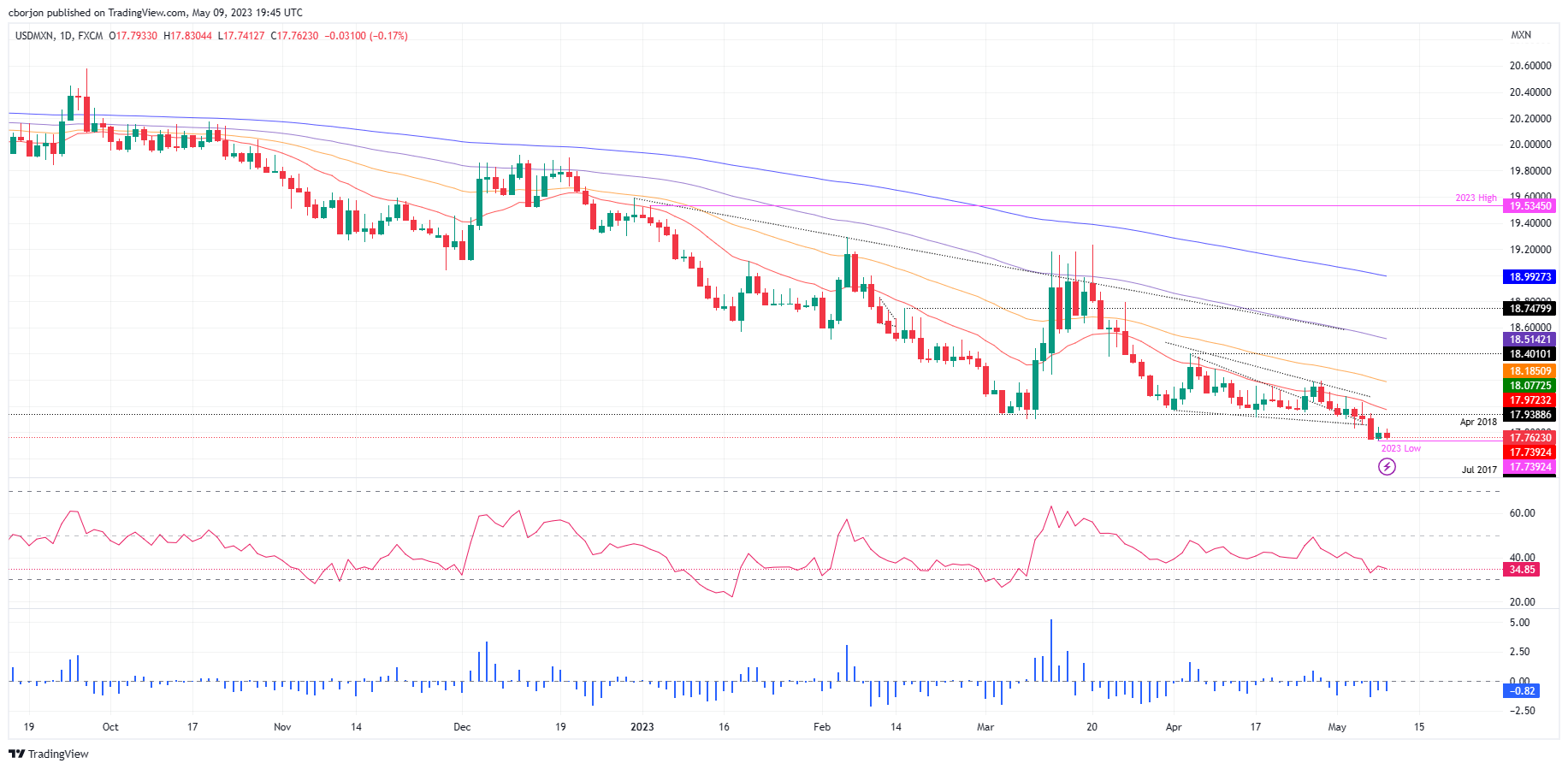- Inflation in Mexico slows for the third consecutive month, which suggests a pause in rate hikes.
- Issues related to the US debt ceiling and Federal Reserve spokespersons are in the spotlight, weighing on market sentiment.
- The future direction of the USD/MXN may depend on upcoming US inflation data, with the possibility of a breakout of key levels.
USD/MXN dips towards the 17.7000 area after a better than expected inflation report in Mexico could open the door for a pause at Mexico’s central bank. Although usually a sign that the currency should weaken, falling US bond yields supported the USD/MXN pair, despite overall US dollar (USD) strength. The USD/MXN pair is trading at 17.7687, down 0.17%.
The Mexican peso remains resilient despite falling inflation, justifying a pause for Mexico’s central bank
USD/MXN resumed its downtrend after INEGI reported that inflation in Mexico slowed for the third consecutive month in April to 6.25% from 6.85% y/y. The Consumer Price Index (CPI) in Mexico fell 0.02% month-on-month, while the core CPI rose 0.39% month-on-month, while the annual stood at 7.67%.
The Bank of Mexico (Banxico’s) raised rates 25 basis points at the March meeting to 11.25%, while opening the door to a pause. Today’s inflation report could pave the way for a pause in the May 18 meeting, as a survey by Citibanmes shows, according to which most market participants believe that Banxico will keep rates unchanged.
Apart from this, the issue of the debt ceiling in the United States (US) is grabbing all the headlines. On Monday, US Treasury Secretary Janet Yellen said the government would run out of liquidity on June 1, adding that it would be a “huge blow”, adding that a default would have “tremendously adverse effects” on financial markets.
Meanwhile, the spokesmen for the Federal Reserve, Jefferson, and the president of the New York (NY) Fed, Williams, crossed news crossings. Jefferson made comments about the banking system, adding that inflation is slowing in an “orderly” manner, but omitted to discuss his position for the next meeting. By contrast, John Williams of the New York Fed stated: “We haven’t said we’re done” with raising the rates of intereststressing that the only change is that the US central bank will depend on the data.
Given the background, a further rise in USD/MXN was warranted, but the release of inflation data in the United States (US) would determine the fate of USD/MXN. If the US CPI for April beats the bullish estimates, USD/MXN would be buoyed by expectations of further tightening by the Fed. Otherwise, USD/MXN could print another leg lower and challenge the current year-to-date low of 17.7392, on its way to the July 2017 low of 17.45.
USD/MXN Technical Analysis

USD/MXN bounced from year-long lows, creating a weekly high of 17.8404 before reversing course. If buyers of the USD/MXN want to regain control, they need to break out of the 20-day EMA at 17.9722. A break of the latter would expose the 18.00 area, followed by the 50 day EMA at 18.1850, before posing a threat to the 100 day EMA at 18.5142. Conversely, USD/MXN could create a fresh 6-year low below 17.7392, around 17.50, following the July 2017 low.
USD/MXN
| Overview | |
|---|---|
| Last price today | 17.7646 |
| Today Change Daily | -0.0314 |
| today’s daily variation | -0.18 |
| today’s daily opening | 17,796 |
| Trends | |
|---|---|
| daily SMA20 | 17,998 |
| daily SMA50 | 18.2073 |
| daily SMA100 | 18.5683 |
| daily SMA200 | 19.2182 |
| levels | |
|---|---|
| previous daily high | 17.8405 |
| previous daily low | 17.7403 |
| Previous Weekly High | 18,078 |
| previous weekly low | 17.7459 |
| Previous Monthly High | 18.4018 |
| Previous monthly minimum | 17.9329 |
| Fibonacci daily 38.2 | 17.8022 |
| Fibonacci 61.8% daily | 17.7786 |
| Daily Pivot Point S1 | 17,744 |
| Daily Pivot Point S2 | 17,692 |
| Daily Pivot Point S3 | 17.6438 |
| Daily Pivot Point R1 | 17.8442 |
| Daily Pivot Point R2 | 17.8925 |
| Daily Pivot Point R3 | 17.9445 |
Source: Fx Street
I am Joshua Winder, a senior-level journalist and editor at World Stock Market. I specialize in covering news related to the stock market and economic trends. With more than 8 years of experience in this field, I have become an expert in financial reporting.







